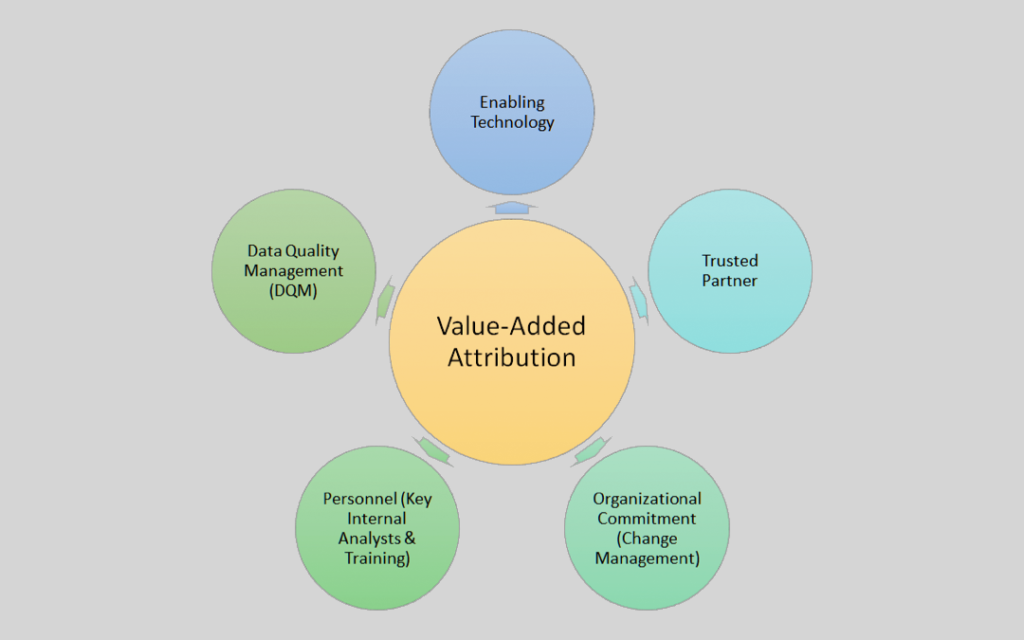There is a new generation of attribution platforms that allow marketers to leverage considerable insights gained in moving from single touchpoint attribution models to more sophisticated multi-touch conversion models. Pushing these enabling technologies to the next step means using those attribution insights to more precisely optimize marketing activities. This includes bid optimization on fractional conversion data and marketing mix modeling (MMM) features. Creating more sophisticated attribution models is only one part of the equation; enabling direct integration with marketing platforms is the other crucial component. Google Attribution 360 is positioned to be at the forefront of leading edge attribution platforms.
Not only has attribution moved away from traditional single-touchpoint models, attribution platforms have also moved heavily in the direction of algorithmic attribution modeling. One example is Google adding data-driven attribution (DDA) to its paid Analytics 360 offering. DDA uses a variation of the Shapley Value Formula to derive the incremental value of each contributing touchpoint in each unique conversion path. In GA360, the model includes up to four touchpoints, but in the Attribution 360 platform, which relies on a similar, more sophisticated underlying algorithm, there is no limit to the number of touchpoints modeled. This is a powerful step up, making a significantly larger universe of interactions available for analysis in your attribution reports.
It’s great to be able to say that in a particular unique conversion path, non-branded paid search should get 32% of credit for conversions, but even better is being able to directly apply that data to your bid optimization rules in your search management platform to adjust your bidding based on this proportional credit for a given channel.
This is the impetus behind the Google Attribution and Attribution 360 (A360) product suite: to make attribution insights more comprehensive in scope and more actionable in nature, making attribution a core driver of marketing success. Google Attribution 360 feature built-in functionality to export your data-driven attribution fractional conversion data directly to SEM and DSP platforms to drive your bid optimization rules more appropriately. See Google’s official product announcement for details.
The question you may be asking at this point is, “What should my organization be doing now to get ready to use the Attribution 360 product?” Here are our suggestions to help you get your data ready to provide better Attribution:
- Tech & Platform Requirements
- Data Quality Management
- Operations & Personnel

Tech & Platform Requirements:
Strong attribution insights rely on data and platforms capable of unifying this data in meaningful ways. As Attribution 360 gets closer to release, Google will release the full set of platform requirements as well as minimum impression and conversion thresholds to ensure that Attribution 360 can be a good fit for your organization, can integrate data properly, and can have meaningful data sets to generate actionable attribution insights.
If it turns out that Google Attribution 360 is not the best fit for an organization, there are other robust attribution tools available that can provide value for your marketing efforts, including the free version of Google Attribution planned for upcoming release:
- Google Attribution (free)
- Google Analytics 360 (GA360): Data-Driven Attribution
- Google Analytics (Free): Standard Attribution Models
- DoubleClick Campaign Manager (DCM) Attribution Modeling
- DoubleClick DS (DS) Attribution Modeling
- Google Adwords Attribution
Data Quality Management:
Where data is concerned, you can trust the cliché: “garbage in equals garbage out.” Attribution modeling, particularly data-driven attribution, relies on quality data to provide meaningful fractional conversion values to your marketing efforts.
The Attribution 360 platform integrates data in several different ways, so the complexities of Data Quality Management (DQM) are also more demanding. For purposes of simplicity, the data requirements for A360 can be grouped into five main categories:
- Campaign Impression & Click Data
- Campaign Cost Data
- Data Extension/Enhancement
- Conversion Interactions
Campaign Impression & Click Data: This data is essential for assessing how people are learning about your brand/product, how they are getting to your website, and what is ultimately driving them to convert into leads and/or customers. Data quality has at least two critical components here.
First, your campaign tracking should be comprehensive. You need to be certain that you truly are tracking every campaign activity that it is possible to track. All of your display & rich-media should be trafficked through your DCM ad server account; you should have DoubleClick’s natural search tag implemented and properly configured; additionally, you should be leveraging impression and click trackers whenever possible for your non-display and non-rich media campaigns.
Second, your campaign tracking should be consistent. If you haven’t done this in a while, it is time to get all the channel and account managers in a room to reinforce the need for consistent campaign naming conventions across your organization. The Attribution 360 platform has multiple ways of getting at your campaign tracking data: campaign names can be parsed with rules-based logic, allowing you to break down potentially large, richly descriptive campaign names into meaningful dimensions:
Awareness|Miami|Lookalike Audience: High-Value Repeat Purchasers|20% Off Orders Over $250|Holiday 2017|Video Pre-Roll
This example campaign could be parsed according to rules for each element separated with a pipe into the corresponding dimension:
Tactic|Geo-Targeting|Target Audience|Offer/Promotion|Campaign|Ad Format
If your campaign naming is either limited or inconsistent (or worse yet, both), then the underlying data used for attribution will also be limited and inconsistent, making your attribution insights unreliable and potentially misleading.
A360 also can ingest query string parameter/value pairs, so this is another opportunity to enhance the data dimensions you capture. Again, this is an important aspect to get right from the start. Make sure that all key stakeholders (channel and account managers) are on the same page about which parameters should be used for which dimensions. Agree on acceptable values for each parameter, and also enforce organization-wide consistency in implementation by leveraging URL builder tools and built-in features that auto-append key data to your campaign clickthrough URLs in an automated fashion.
Campaign Cost Data: Campaign cost data is a key component of attribution because it can give you much better awareness not only of how much conversion credit each channel or campaign should be receiving but also what the ROAS and ROI of those efforts are related to actual marketing spend.
If your organization spends considerable time and effort auditing your campaign cost data and ensuring that it is 100% accurate (or as close as possible) within the DoubleClick environment, you’ll be pleased to know that A360 can ingest that cost data directly. You may find it is worth the additional investment to get your data right directly within DCM.
However, many large advertisers rely on their back-end systems to have the most accurate media spend numbers which reflect delivered impressions as well as any fees associated with campaigns. A360 can also ingest these other marketing cost data sources if they are your most accurate source of truth for cost data. Again, this is a key component to getting Data Quality Management right. Find out now if you are tracking your marketing costs in a way that can serve as an accurate data source for A360.
Data Extension/Enhancement: A360 allows you to load reference files to extend your campaign data in powerful ways. With a simple join key, such as a campaign ID or other shared data dimension, reference file data will be matched with corresponding campaigns to give you additional dimensions for that campaign and/or channel.
This may allow you to simplify your tracking and tagging setup. You could capture just a campaign identifier, for example and then use reference files from your database to provide the extended campaign detail, such as targeting, tactic, ad format, messaging, offers or any other meaningful details as reportable dimensions.
Conversion Data: How are you tracking key conversion activities: GA conversion goals, enhanced eCommerce transactions, DoubleClick Floodlights, or all three? A360 accommodates both GA conversions and floodlight conversions, so you want to decide which conversion events you want to use for your attribution insights. Because GA and floodlights can potentially be tracking the same conversion events, you want to be sure you are not double or triple counting your conversions and or revenue by using redundant conversions.
Again, if you have not visited your conversion tracking in a while, now is the time to sit down and audit for the following:
- Are your GA conversion goals defined correctly, whether they are URL based or event-based goals? This is a basic configuration question, but it’s worth going back to the basics
- Are your floodlight tags configured correctly to count conversions the way you expect them to (one conversion per item sold, for example, or one conversion per transaction), and are you passing inaccurate revenue data with your floodlight tags?
- Do you have enhanced eCommerce tracking enabled in your GA account, and are you capturing both transaction counts and accurate revenue data for these transactions?
- Again, if you are capturing all three of the above conversion types, make sure that you know which conversion tracking you want to use for attribution purposes so that you don’t overstate conversions by using multiple conversions that are redundant to one another
Audit, Audit, Audit: If you are thinking comprehensive audit at this point, your head is in the right place. A360 uses a complex algorithm incorporating potentially complex data sources, so it is crucially important to get the data quality managed correctly in a comprehensive manner. When you set out to implement A360, part of the onboarding and implementation process will be a serious look at data quality with your implementation partner. However, if you know you want to be in a position to leverage this new platform, there is nothing stopping you from getting your data quality ducks in a row.
Operations & Personnel:
Two big operational & personnel-related components will impact the success of your Attribution 360 implementation and full rollout: 1) organizational support for leveraging attribution insights to make informed marketing decisions; 2) competent data & analyst roles within your organization to support organization-wide adoption.
Organizational Support: Successful engagements with advanced attribution requires organization-wide support from executives down to directors and account managers. Data-driven attribution will generate significant shifts in how your marketing programs are evaluated in terms of performance against clearly defined business objectives and KPIs. As a matter of executive commitment, company culture, and change management you have to be prepared for aligning marketing personnel and marketing decisions with what these new insights are telling you.
Short-term it will be an adjustment for your teams, who have likely been measuring their own performance and reporting it to the company based on last-click models for the life of your company’s digital presence.
Very quickly you are going to be asking them to base their performance on fractional conversion values based on data-driven attribution, and it will change the picture more or less significant depending on how heavily a particular channel skews toward being a last-click converter. If you are committed for the long haul as an organization, you can easily recalibrate expectations and set new benchmarks and standards once you have a new source of validated performance insights.
Internal Analyst & Data Support: Consultants and support partners are a necessary and helpful component to successful platform rollouts. However, if you want to successfully implement and fully utilize Attribution 360 you need to have a competent data and analyst team internal to your organization to help you leverage and implement the necessary changes to your marketing activities while helping to ensure the ongoing investment in DQM and proactive analysis this will require.
This may seem like early days for a product that has not launched out of closed Beta, but if your organization is a good candidate for Attribution 360 and you are serious about implementing this solution when it becomes available this is more like the 11th hour for ensuring you have the necessary requirement and quality data components in place to ensure your success. Even if you just want to be in a good position to leverage the free Google Attribution product once it is released, it will still be imperative to get all of the data elements in alignment to get the most out of this platform.
Yes, a trusted partner will be essential for helping you map out and execute this project, but it is imperative that you invest internally in these initiatives as well.














